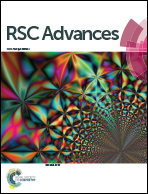Controlled growth of MoS2 nanopetals and their hydrogen evolution performance†
Abstract
Edge-oriented MoS2 nanopetals complexed with basal-oriented MoS2 thin films have been mildly grown through a simple atmospheric pressure chemical vapor deposition (APCVD) process with the reaction of MoO3 and S. Dense nanopetals with hexagonal structures exposed numerous chemically reactive edge sites. The roles of growth temperature, time and S/MoO3 mass ratio have been carefully investigated to tune the morphology and density of the as-grown products. Importantly, the carbon nanotube (CNT) films were used as substrates for growing MoS2 nanopetals. The MoS2/CNT composites, used directly as working electrodes, showed remarkable and stable electrocatalytic activity in the hydrogen evolution reaction (HER), as manifested with a low onset overpotential of ∼100 mV and a small Tafel slope of 49.5 mV per decade. The development of the MoS2/CNT electrode provides a promising way to fabricate other multifunctional electrodes.


 Please wait while we load your content...
Please wait while we load your content...